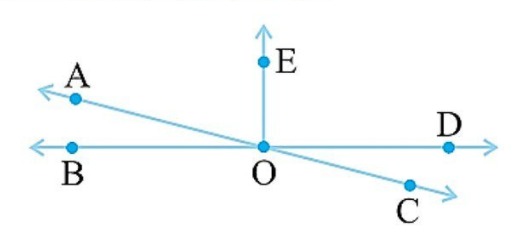Consider the following
statements:
When two straight lines
intersect:
(i)adjacent angles are
complementary
(ii)adjacent angles are supplementary
(iii)opposite angles are equal
(iv)opposite angles are supplementary
Of those statements
(a) (i) and (iii) are correct
(b) (ii) and (iii) are correct
(c) (i) and (iv) are correct
(d) (ii) and (iv) are correct
2 and 3 are correct
1 and 4 are correct
1 and 3 are correct
2 and 4 are correct
The correct Answer is:A
Step by step video, text & image solution for Consider the following statements: When two straight lines intersect: (i)adjacent angles are complementary (ii)adjacent angles are supplementary (iii)opposite angles are equal (iv)opposite angles are supplementary Of those statements (a) (i) and (iii) are correct (b) (ii) and (iii) are correct (c) (i) and (iv) are correct (d) (ii) and (iv) are correct by Maths experts to help you in doubts & scoring excellent marks in Class 14 exams.
Topper's Solved these Questions
- BOOK - ARIHANT SSCCHAPTER - GEOMETRYEXERCISE - INTRODUCTORY EXERCISE - 12.2100videos
GEOMETRY
- BOOK - ARIHANT SSCCHAPTER - GEOMETRYEXERCISE - INTRODUCTORY EXERCISE - 12.328videos
GEOMETRY
- BOOK - ARIHANT SSCCHAPTER - GEOMETRYEXERCISE - Fast Track Practice104videos
GEOMETRY
- BOOK - ARIHANT SSCCHAPTER - FUNDAMENTALS EXERCISE - TEST OF YOU - LEARNING - 240videos
FUNDAMENTALS
- BOOK - ARIHANT SSCCHAPTER - HCF AND LCMEXERCISE - Exercise Higher Skill Level Questions18videos
HCF AND LCM
Similar Questions
Knowledge Check
- Question 1 - Select One
Answer on the basis of the following statements. When two straight lines intersect, then :
adjacent angles are complementary
adjacent angles are supplementary
opposite angles are equal
opposite angles are supplementaryA2 and 3 are correctB1 and 4 are correctC1 and 3 are correctD2 and 4 are correct - Question 2 - Select One
Consider the following statements & choose the correct options:
When two straight lines intersect then,
1. Adjacent angles are supplementary
2. Opposite angles are supplementary
A. Both 1 & 2 are incorrect.
B. Both 1 & 2 are correct
C. 1 is incorrect and 2 is correct
D. 1 is correct and 2 is incorrectABBACCDD - Question 3 - Select One or More
The correct statements (s) regarding,
(i) HClO,
(ii) HClO2 ,
(iii) HClO3
(iv) HClO4 is areAThe number of Cl=O bonds in (ii) and (iii) together is twoBThe number of lone pairs of electrons on Cl in (ii) and (iii) together is threeCThe hybridization of Cl in (iv) is sp3DAmongst (i) to (iv), the strongest acid is (i)
Can two angles be supplementary if both of them are:
(i) acute? (ii) obtuse? (iii) right?View SolutionDefine the following terms :
(i) Angle
(ii) Interior of an angle
(iii) Obtuse angle
(iv) Reflex angle
(v) Complementary angles
(vi) Supplementary anglesView SolutionFind : (i) 932 (ii) 3225 (iii) 1634 (iv) 125−13
View SolutionTheorem in a parallelogram prove that (i)the opposite sides are equal; (ii) the opposite angles are equal ;(iii) diagonals bisect each other.
View SolutionIn the adjoining figure, name the following pairs of angles.(i) Obtuse vertically opposite angles(ii) Adjacent complementary angles(iii) Equal supplementary angles(iv) Unequal supplementary angles(v) Adjacent angles that do not form a linear pair
 View Solution
View Solution
